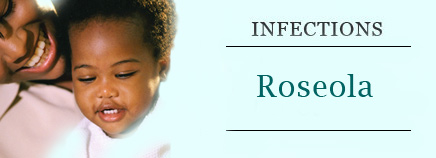
About Roseola
Roseola (also known as sixth disease, exanthem subitum, and roseola infantum) is a viral illness that most commonly affects young kids between 6 months and 2 years old.
It is usually marked by several days of high fever, followed by a distinctive rash just as the fever breaks.
Two common, closely related viruses can cause roseola, human herpesvirus (HHV) type 6 and type 7. These viruses belong to the same family as the better-known herpes simplex viruses (HSV), but do not cause the cold sores and genital herpes infections that HSV can cause.
Signs and Symptoms
Most children with roseola develop a mild upper respiratory illness, followed by a high fever (often higher than 103°F or 39.5°C) for up to a week. During this time, a child might be fussy or irritable, not eat as much as usual, and may have swollen lymph nodes (glands) in the neck.

The high fever often ends abruptly, and at about the same time a pinkish-red flat or raised rash starts on the trunk. The rash’s spots turn white when touched, and individual spots may have a lighter “halo” around them. The rash usually spreads to the neck, face, arms, and legs.
This fast-rising fever can trigger febrile seizures (convulsions caused by high fevers) in about 10% to 15% of young children who have roseola. Signs of a febrile seizure include:
- unconsciousness
- 2 to 3 minutes of jerking or twitching in the arms, legs, or face
- loss of control of the bladder or bowels
Contagiousness
Roseola is contagious. The infection spreads when a child with roseola talks, sneezes, or coughs, sending tiny droplets into the air that others can breathe in. The droplets also can land on surfaces; if other children touch those surfaces and then their nose or mouth, they can become infected.
Roseola may be contagious during the fever phase, but does not spread by the time the rash breaks out.
Prevention
There is no known way to prevent roseola. But because it affects young kids rather than adults, it’s thought that a bout of roseola in childhood may provide some lasting immunity to the illness. Repeat cases of roseola can happen, but are uncommon.
Duration
The fever of roseola lasts from 3 to 7 days, followed by a rash lasting from hours to a few days.
Professional Treatment
To make a diagnosis, a doctor will take a medical history and do a thorough physical examination. A diagnosis of roseola is often uncertain until the fever drops and the rash appears, so the doctor may order tests to make sure that the fever is not caused by another type of infection.
Roseola usually does not require professional treatment. When it does, most treatment is focused on lowering the high fever. Antibiotics can’t treat roseola because viruses, not bacteria, cause it.
Home Treatment
Acetaminophen (such as Tylenol) or ibuprofen (such as Advil or Motrin) can help to ease your child’s fever. Never give aspirin to a child who has a viral illness because its use in such cases has been associated with Reye syndrome, which can lead to liver failure and death.
While some parents use lukewarm sponge baths to lower fever, there is no evidence that this really works. In fact, sponge baths can make children uncomfortable. Never give your child an icy or cold bath or alcohol rubs.
To prevent dehydration from the fever, encourage your child to drink clear fluids such as water with ice chips and children’s electrolyte solutions. Breast milk and formula can help prevent dehydration as well.
When to Call the Doctor
Call the doctor if your child is lethargic or won’t drink or breastfeed. If your child has a seizure, seek emergency care immediately.

